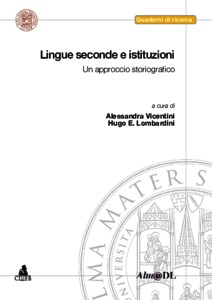Arribas, Nieves
(2019)
De la escrituridad didáctica a la grabación sonora. Panorama metateórico e historiográfico de diálogos ELE.
DOI
10.6092/unibo/amsacta/6548.
In: Lingue seconde e istituzioni: Un approccio storiografico.
A cura di:
Vicentini, Alessandra ;
Lombardini, Hugo E..
Bologna:
Clueb,
.
ISBN 978‐88‐491‐5666‐9.
In: Quaderni del CIRSIL, (13).
ISSN 1973-9338.
Full text disponibile come:
![[thumbnail of CIRSIL 13 - 08 Arribas.pdf]](https://amsacta.unibo.it/6548/1.hassmallThumbnailVersion/CIRSIL%2013%20-%2008%20Arribas.pdf)  Anteprima |
Documento di testo(pdf)
Licenza: Salvo eventuali più ampie autorizzazioni dell'autore, il contributo può essere liberamente consultato e può essere effettuato il salvataggio e la stampa di una copia per fini strettamente personali di studio, di ricerca e di insegnamento, con espresso divieto di qualunque utilizzo direttamente o indirettamente commerciale. Ogni altro diritto sul materiale è riservato.
Download (607kB)
| Anteprima
|
Abstract
Linguistic communication through printed texts is asynchronous – lacking a biunivocal and reciprocal temporal correspondence between sender and receiver – and this is especially relevant in the case of dialogues designed to teach foreign languages. Imitating oral speech in written texts historically constitutes a whole discursive, prototypical yet not exclusive tradition of literary creation. Within the broad variational continuum of textual genres with written dialogues, those belonging to the field of Spanish as a Foreign Language face an added difficulty in their mimesis of spoken language: reproducing speech samples in linguistic diasystems that are different from those of the native language of the receiver. At the end of the 19th century, the importance of oral speech was emphasised in linguistics; however, it was only later that the diamesic aspects of speech were distinguished from the conceptual ones. Without claiming to expose anything novel, the origin of this unbroken teaching tradition will be outlined in order to analyse what samples of conversationality were created particularly for Italian-speaking Spanish learners from the end of the 19th century until the emergence of sound recording at the beginning of the 20th century, what type of “written spoken language” or “written orality” (“escritur(al)idad”, writtenness)2 tried to account, at least in part, for expressions belonging to an informal and relaxed conversation, and what linguistic theories supported the evolution of this variational continuum.
Abstract
Linguistic communication through printed texts is asynchronous – lacking a biunivocal and reciprocal temporal correspondence between sender and receiver – and this is especially relevant in the case of dialogues designed to teach foreign languages. Imitating oral speech in written texts historically constitutes a whole discursive, prototypical yet not exclusive tradition of literary creation. Within the broad variational continuum of textual genres with written dialogues, those belonging to the field of Spanish as a Foreign Language face an added difficulty in their mimesis of spoken language: reproducing speech samples in linguistic diasystems that are different from those of the native language of the receiver. At the end of the 19th century, the importance of oral speech was emphasised in linguistics; however, it was only later that the diamesic aspects of speech were distinguished from the conceptual ones. Without claiming to expose anything novel, the origin of this unbroken teaching tradition will be outlined in order to analyse what samples of conversationality were created particularly for Italian-speaking Spanish learners from the end of the 19th century until the emergence of sound recording at the beginning of the 20th century, what type of “written spoken language” or “written orality” (“escritur(al)idad”, writtenness)2 tried to account, at least in part, for expressions belonging to an informal and relaxed conversation, and what linguistic theories supported the evolution of this variational continuum.
Tipologia del documento
Estratto da libro
Autori
Parole chiave
writtenness, didactic dialogues, Spanish as a Foreign Language, sound recording
Settori scientifico-disciplinari
ISSN
1973-9338
ISBN
978‐88‐491‐5666‐9
DOI
Data di deposito
16 Dic 2020 10:30
Ultima modifica
16 Dic 2020 10:30
URI
Altri metadati
Tipologia del documento
Estratto da libro
Autori
Parole chiave
writtenness, didactic dialogues, Spanish as a Foreign Language, sound recording
Settori scientifico-disciplinari
ISSN
1973-9338
ISBN
978‐88‐491‐5666‐9
DOI
Data di deposito
16 Dic 2020 10:30
Ultima modifica
16 Dic 2020 10:30
URI
Statistica sui download
Statistica sui download
Gestione del documento:



 Login per gli autori
Login per gli autori



